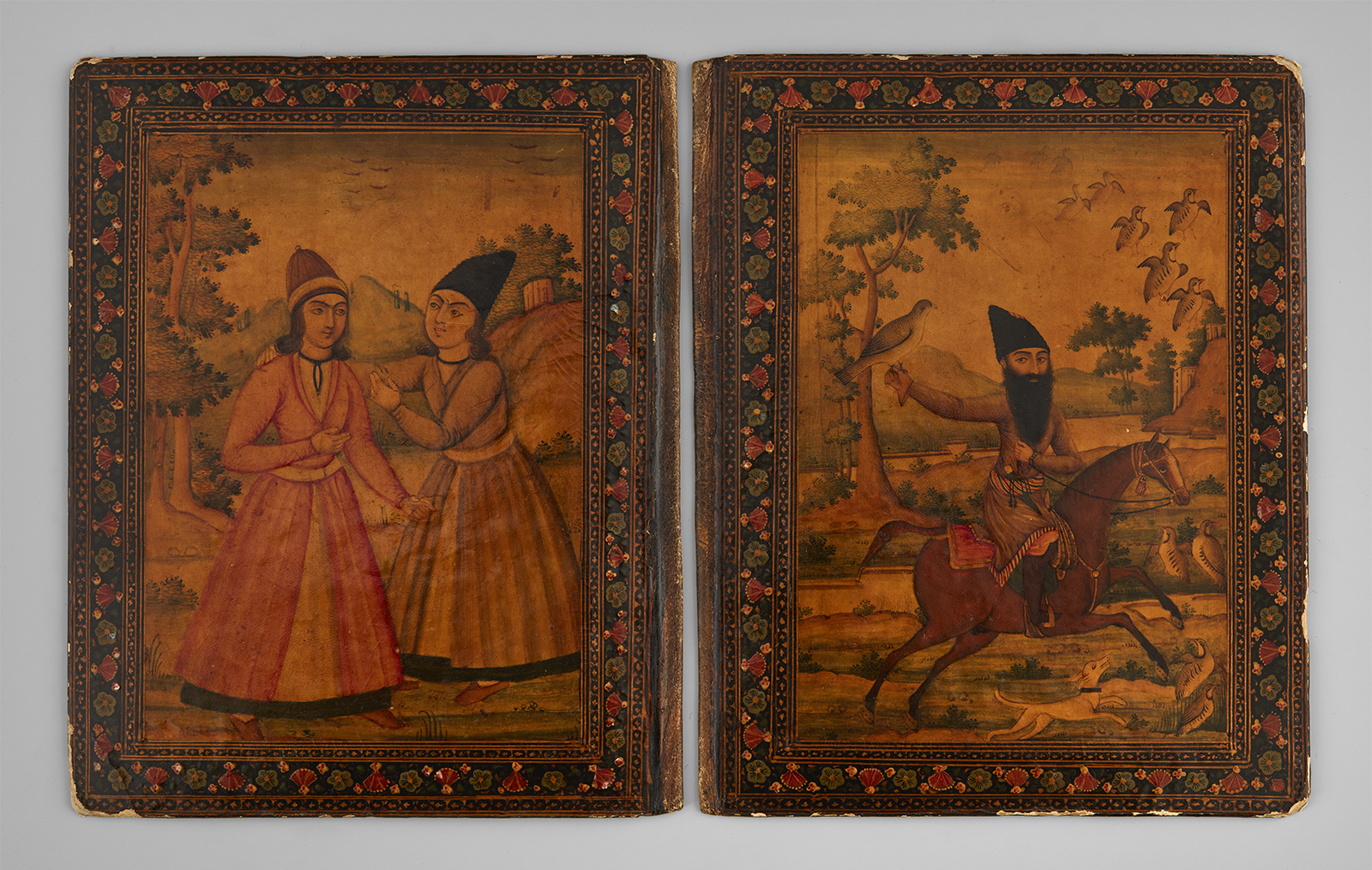Click on the image to zoom
Pair of lacquer book covers
- Accession Number:AKM395
- Place:Iran
- Dimensions:21 x 16.4 cm
- Date:ca. 1800–40
- Materials and Technique:Papier-mâché, oil paint and lacquer
This binding has been detached from the unknown manuscript it once covered. The front cover depicts Fath ʻAli Shah Qajar (second ruler of the Qajar dynasty, r. 1798–1834), reportedly a passionate and skilled falconer, astride a horse holding a falcon as he looks out at the viewer. The back cover depicts a conversation between a youth, possibly a prince, and a young wandering dervish (qalandar), an image associated with Sufism, the mystical branch of Islam. The absence of the original manuscript makes it is difficult to confirm the intended meaning of the images on these covers or the connection between them.
Further Reading
Depictions of Fath ‘Ali Shah hunting are found in a wide range of media, including exceptional lacquer bindings and boxes signed by Muhammad Baqir and Sayyid Mirza (now in the British Library); a monumental painting in the Former Viceroy’s Palace (Ashoka Hall, Rashtrapati Bhawan) in New Delhi; and rock reliefs at Firouz Kuh at Tanga-yi Savashi and in Rayy. Yet, in none of these examples is he portrayed as a lone falconer. This dearth of imagery is surprising, given that Fath ʻAli Shah Qajar was reportedly a passionate and skilled falconer who spent hours and sometimes weeks engaged in a sport that, for centuries, was a symbol of the fortune, power, and stability of the thriving sovereign. As well, artistic, literary, and historical references to falconry (baz-dari) and hawking parties are numerous. One foreign observer mentions that it was common for people of distinction to keep falcons, sparrow hawks, and other birds of prey for sporting. A few early life-size Qajar paintings on canvas also show youths holding falcons, including one in the Hermitage Museum Collection, Petersburg and a painting in the collection of the Metropolitan Museum of Art.[1]
It is unclear why a dervish is depicted on the back cover of this binding. While Sufism experienced a revival in Iran during the late 18th and early 19th centuries, Sufis became a powerful force whose members were often viewed with suspicion by the court and the state-supported ʻulama (clerics). Unlike his successor Muhammad Shah Qajar, Fath ʻAli Shah was not very engaged in Sufi activities. He also sided frequently with the clerics who were increasingly hostile toward Sufis.
— Mariam Ekhtiar
Notes
[1] The painting of a young prince holding a falcon is now in the collection of the Metropolitan Museum of Art, accession number: 2017.646.
References
Alam, Houshang, “Bazdari,” Encyclopedia Iranica, vol. IV, Fasc. 1, 53–58. ISBN: 9780710091284
Amanat, Abbas, Resurrection and Renewal: The Making of the Babi Movement in Iran, 1844–1850, Ithaca, NY: Cornell University Press, 1989, 76–77. ISBN: 9780801420986
Diba, Layla S. with Ekhtiar, Maryam, Royal Persian Painting: The Qajar Epoch 1785-1925. London and New York: IB Tauris and The Brooklyn Museum of Art, 1998. ISBN: 9781860642555
Froom, Aimeé, Spirit and Life: Masterpieces of Islamic Art from the Aga Khan Museum Collection, Geneva: Aga Khan Trust for Culture 2007, no. 121. ISBN: 9782940212026
Note: This online resource is reviewed and updated on an ongoing basis. We are committed to improving this information and will revise and update knowledge about this object as it becomes available.


